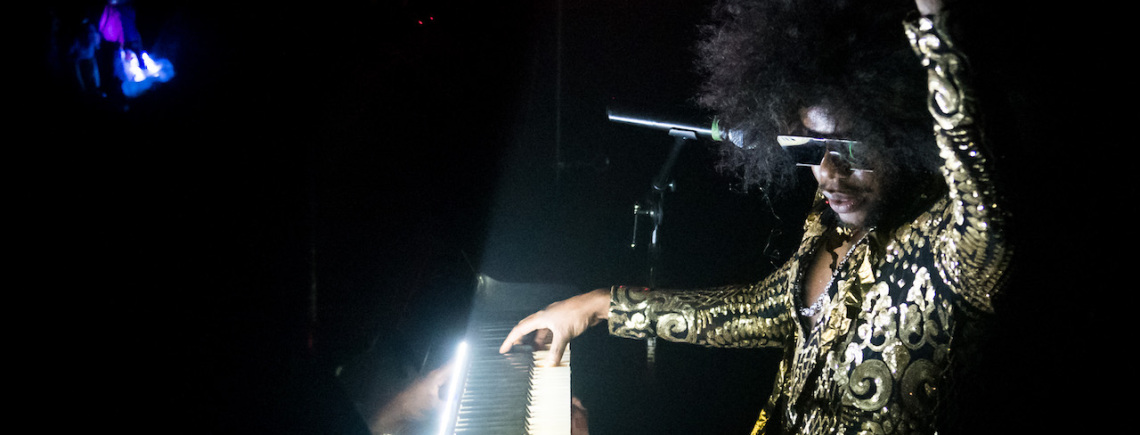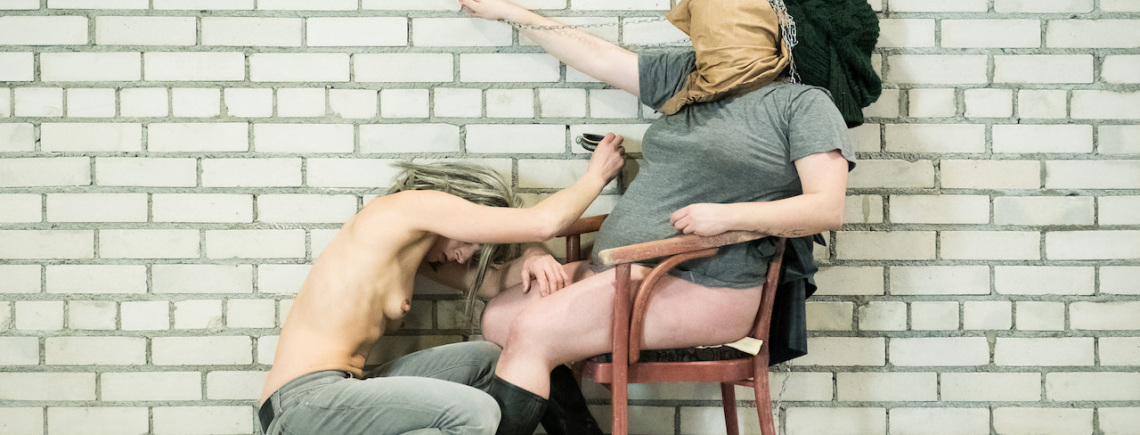Archives
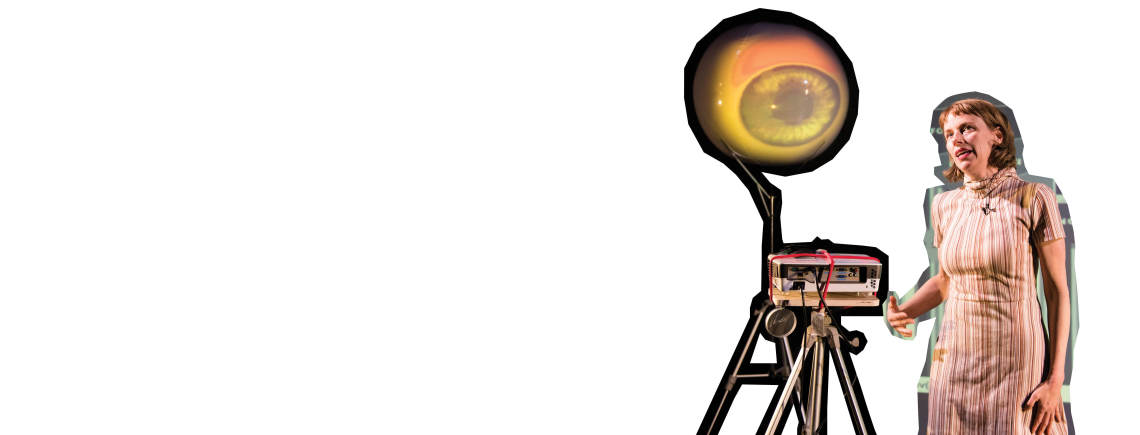
Michelle Ellsworth
Preparation for the Obsolescence of the Y Chromosome
Friday, June 8, 8:00pm
Saturday, June 9, 8:00pm
Run time: 50 minutes
Hollins University, Studio Theater
Roanoke, Virginia
FREE
Preparation for the Obsolescence of the Y Chromosome attempts to prepare (both on a micro and macro level) for the end of men. Simultaneously committed to conservation and archival efforts, Ellsworth works in the tradition of folklorist Alan Lomax. Using web technology, replacement apparatus (including a male gaze simulator), choreography (including gratitude-inspired token gestures), and the latest data from the Whitehead Institute at MIT, this work both combats and fuels rumors about the implications of the Y Chromosome’s reputed shrinkage.
Preparation for the Obsolescence of the Y Chromosome was commissioned by MCA Denver’s Feminism + Co and EcoArts Connections.
photo by Ian Douglas
Michelle Ellsworth: Preparation for the Obsolescence of the Y Chromosome from Marin Media Lab on Vimeo.
PreyYtrailer2 from michelle ellsworth on Vimeo.
Conceived, Created, and Performed: Michelle Ellsworth
Web Designer and Programmer: Satchel Spencer
Lighting designer: Ryan Seelig
Set and Props: Priscilla Cohan
Preparation for the Obsolescence of the Y Chromosome was commissioned by MCA Denver’s Feminism + Co.
Priscilla Cohan received her Bachelor of Fine Art from University of Colorado in Studio Ceramics. Her work in the theater includes performances in Richard Goulis’ Block, and as a puppet in Jainie Geisers’ Evidence of Floods, House of Birds by George Peters and Melanie Walker, and in The Adventures of Zimmo!, a 5 DVD for children. Her contributions to stage sets include, Hey, Stop That! written and directed by Thalia Field, The Rise and Fall of Pirate Jenny by Ethelyn Friend and Gifts from Unknown Islands by Mark McCoin.
Michelle Ellsworth makes solo performance/video work, websites, and drawings. She is a 2013 Creative Capital and New England Foundation for the Arts’ NDP Grantee and a 2011 United States Artists Knight Fellow. Ellsworth’s work has been commissioned by: On The Boards, Danspace Project, the National Performance Network, Diverseworks, and Dance Theater Workshop. She has performed and taught at Brown University, Columbia College, Naropa University, The University of Costa Rica, and in Ireland. Her drawings and spreadsheets have been published in CHAIN and her screen dances have been seen around Europe and throughout the U.S. michelleellsworth.com
Ryan Seelig’s Lighting Design credits include: Clytigation dir. Michelle Ellsworth(On The Boards), Early Shaker Spirituals(The Wooster Group), You For Me For You(Ma-Yi Theater Company), MTV’s The Music Experiment: Of Monsters and Men(Angel Orensanz Center). Losing Tom Pecinka (Morgan Gould and Friends), and Dog Eat Dog (Morgan Gould and Friends).
Other: Lighting Supervisor for The Wooster Group and the International tour of Young Jean Lee’s Untitled Feminist Show.
Education: BA from Fordham University at Lincoln Center
Satchel Spencer is video maker, web programmer, photographer, and traceur. His work has been performed at On The Boards, Brown University, Juilliard, the New School, Denver Museum of Contemporary Art, and Dance Theatre Workshop.
“Andrew Dinwiddie and Michelle Ellsworth have scrutinized the act of transformation in two virtuosic solos.”
By Gia Kourlas, The New York Times, Published May 26, 2012
“Tifprabap.org exists online and not just as the title of Michelle Ellsworth’s completely, winningly ridiculous new solo.”
By Claudia La Rocco, The New York Times, Published April 19, 2008
“[A] lark that’s half science and half pure hilarity.”
By Susan Froyd, Westword, Published March 9, 2011
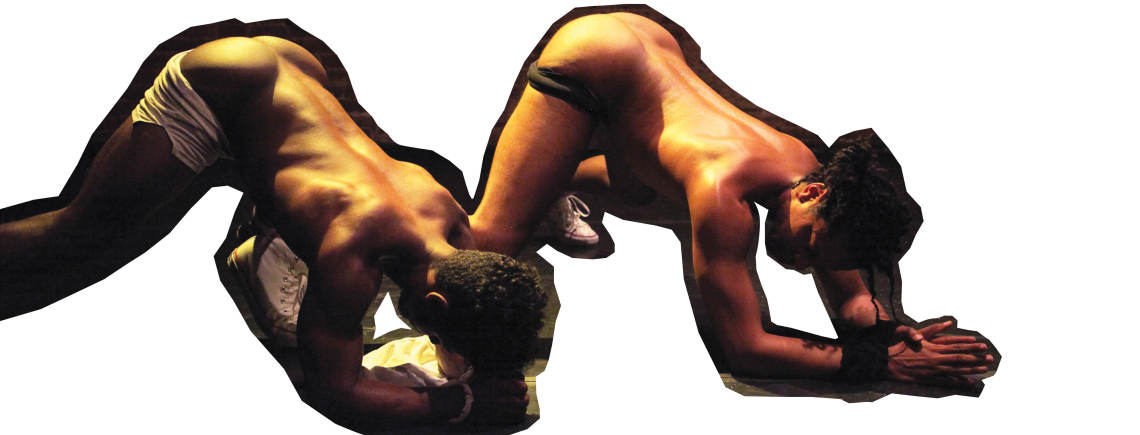
jumatatu m. poe & Donte Beacham
Let ‘im Move You: A Study (2013/2016) and Let ‘im Move You: This Is a Success (2016)
Friday, June 8, 9:30pm
Saturday, June 9, 9:30pm
Run Time: 60 minutes
Hollins University, Theater
Roanoke, Virginia
FREE
Let ‘im Move You is a series of works choreographed by jumatatu m. poe & Jermone “Donte” Beacham that stem from the artists’ seven-year research into J-Sette performance, the performance of joy and the conundrum of Black joy. The series currently consists of three live performance works and an installation.
A Study uses J-Sette movement and performance structures as jumping-off points for experimentation with the role of strategy in collaborative creation and presentation. Rhythm, pattern, and attention become mechanisms for the artists to situate themselves in play, and to frame a movement conversation with primarily White audiences.
This Is a Success explores J-Sette in relation to notions of African-American exceptionalism as expressed through middle class, Black American values reiterated within the J-Sette form. The work continues the artists’ research of rhythm as a vehicle into both subversion and satisfaction.
A Study was first developed in a residency through Kultursekretariat’s Tanzrecherche NRW program at Kulturforum Alte Post in Neuss, Germany. The Let ‘im Move You body of work to date has been made possible through a residency at the 18th Street Arts Center in Santa Monica with support from a Pew Center for Arts & Heritage Fellowship in the Arts.
Photo by Theo Cote

ON GASKIN & KOSOKO
BY KEIJAUN THOMAS
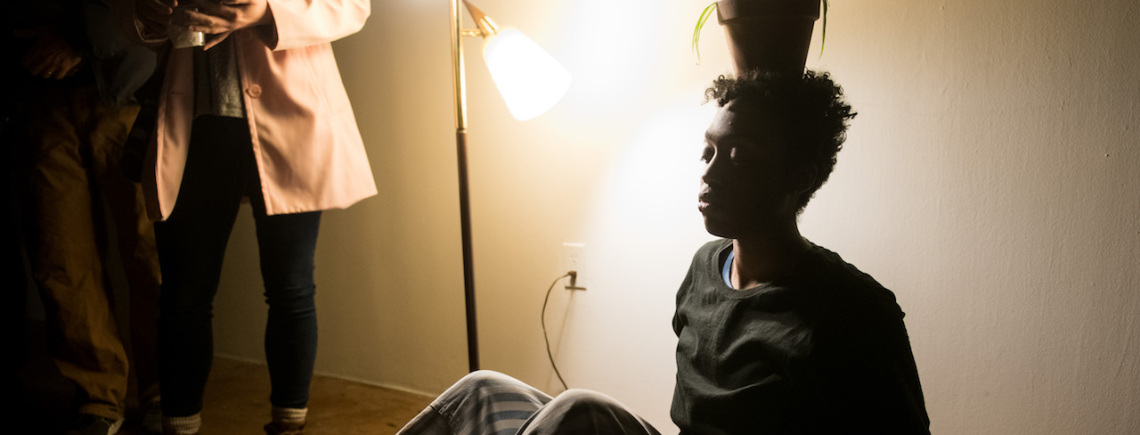
THE POWER OF INTERIORITY
BY ANGIE PITTMAN
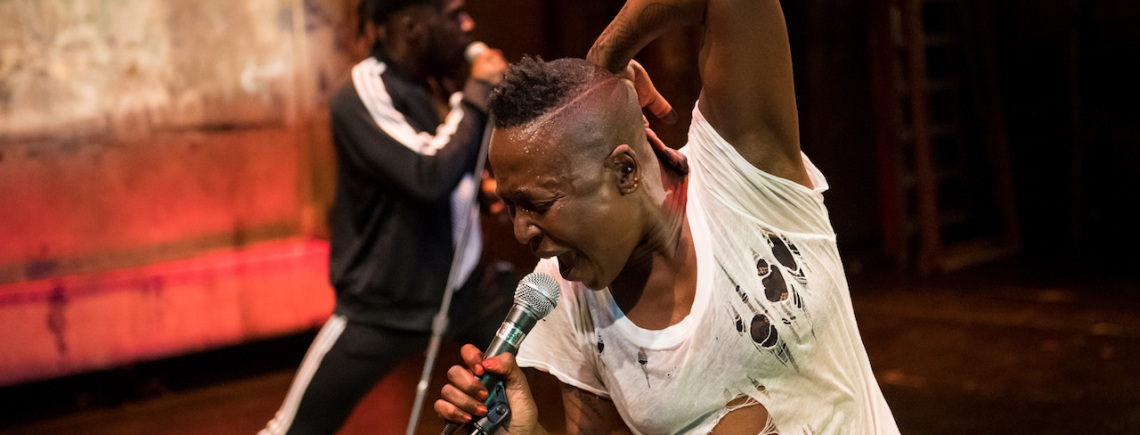
WE’VE GOT SPIRIT. HOW ‘BOUT YOU?
BY JEREMY TOUSSAINT-BAPTISTE
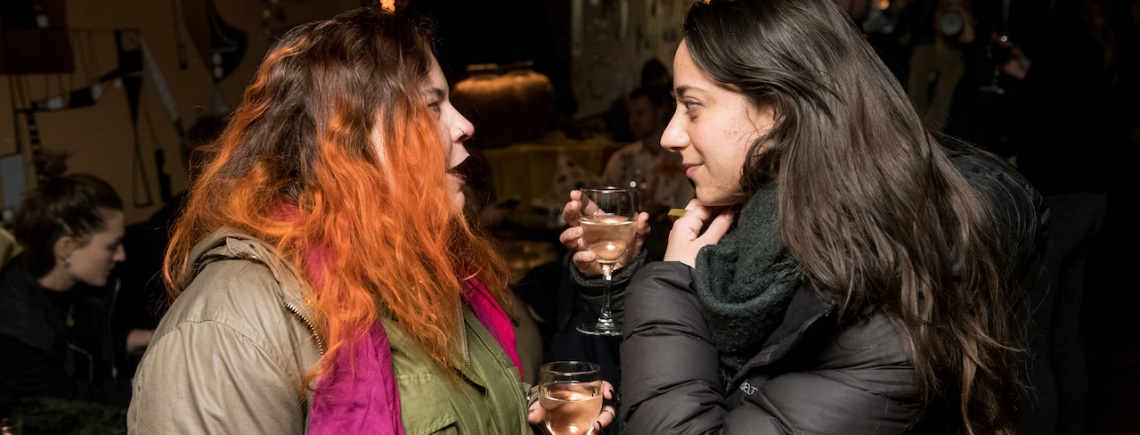
Post Show…an intro
By Stephanie Acosta
To lay in wait of your own responses, to lie in the weight of shared experiences, head full or floating, as you consider and contemplate the ramifications of a happening, of your witnessing—not a review, but rather a retrieval. To keep critical beyond critique—to listen not only to what is said but to what is done, to its resonance-to listen as an expansive act. To read, to write, to return to what cannot be re-tread.
These are the elements that bring me to discourse, to these writers and to our series of readings for American Realness 2018.
As I approached this evolving gathering I wanted the writings to act as a series of responses, discursive moments that allow us to revisit what we’ve seen through the eyes of makers, thinkers, dancers, performance artists and scholars. I know these inspiring individuals might shake and shed some of what you witnessed. I hope they will keep shaping what you see in the artists and works, that you find here new ways of looking, and that their impressions ripple through your own pools of thought. I hope you see not only what was but is, in the aftermath and the afterglow.
Coming forward, a group of six writers spanning aspects of performance in NYC will bring their dynamic views to bear on a select group of works presented this January as part of American Realness.
How did the work live? How might works keep living? Why create this work if not to think and feel more deeply?
Thankfully, we have six chances to do both.
Photo By Ian Douglas

The Power of Interiority
By Angie Pittman
I walk into the space after being on the waitlist. This gives me time to observe keyon with a glass of wine in their hand and lavender lipstick on their lips greeting every person as they come in. While handing them each a numbered book (I assume a system for keeping track of them) they tell folks to feel free to look through the book before and during the performance. The book is a beautiful collection of self portraits; artistically assembled words, photos, and a page of purple sequins. But just as I look at it, I hear keyon say, “Please give them back directly at the end of the show.” Although beautiful, this is an object that I will get to enjoy for the time being. It will not be mine. I will not own it. You deal with the feels associated with that realization as you enter the space. The space is a gallery-esque, empty storefront. It was lowlit, and because I was late, I entered witnessing others already negotiating with each other on where to stand. I couldn’t help but ask, Where is the “best” spot to see the “show”.
There are a couple of house lamps and a hot plate with boiling water in the periphery of the space. I choose to stand next to the boiling water because I liked the sound it made. A performer comes out dressed in a loose fitting cropped tshirt and pants underneath an open bathrobe. They donned tap shoes and balanced a green potted plant on their head navigating the audience nonchalantly. The performance that ensued was a constellation of three performers doing autonomous tasks in and around the crowd. Some of the tasks included boiling a ramen noodle pack (without the seasoning) and then laying out the warm noodles and using it like hair, burning keyon’s hair that was formerly housed in old weed containers, dancing to a Rihanna song playing from an iphone inside a glass pitcher, and walking around with a scarf covering the performer’s face. The whole performance was like a long and slow dream. It ended with keyon shutting on the fluorescent overhead lights abruptly and says “alright give me your books”.
This piece was performed as if it were already a memory. keyon gaskin’s [a swatch of lavender]:a self portrait does the thing that memory does when it conflates time and the senses. I conflated the memory of the smell of burnt hair alongside the subtle tap shoes scraping the floor, even though in “real” time these things happened separately. The volume of the performance seems to be set at “consistent murmur” throughout the duration, making me hyper aware of my own breath. It reminded me of the way it feels to be a little bit drunk at home alone. This dance engages the senses by nudging them. You hear the slight boiling of water from the hot pot in the corner, the scraping of the performer’s tap shoes on the ground, and can almost feel the warm ramen hair on your skin. You can touch and feel the closeness of your fellow audience as you navigate each other in the space and all the emotions along with that (1). It was almost hard to see. It was actually hard to see. Seeing was the hardest sense to engage with in this work because you as an audience member had to grapple with your own dance of seeing and not seeing. Performers were coming and going out of your line of sight. When the dance came near to me, I thought “what a treat” and when it didn’t I delightfully fell back into my other senses or rifled through the book they gave me. Oh this is it. The difficult of “seeing” this work is important. It’s what it is actually. Obscured visibility is the space in which the incapturability of Black performance lives.
I have been watching Get Out on repeat consistently for about a month now. What this practice has reaffirmed is how important it is to not be captured, symbolically and literally. How does one do this? By remaining your own whole Black ass self, whatever that means to you. FURTHERMORE Get Out reminds me that Blackness in and of itself is impossible to capture. Blackness reminds us, no matter how hard whiteness tries to contain it, that it is infinite, uncontainable, and wonderfully uncontrollable (2). So the work becomes reminding people of that simple fact because sometimes wypipo (3) forget and try us. With inscriptions in the book that you are holding like “Dafuq you looking at?” and “I will never come in handy” gaskin is saying, not today. They are constantly pushing against and resisting white voyeurism and its attempt to consume. My bathrobe is open and I DGAF (4). Oh and those beautiful self portraits that I gave you to hold and look through? I will be taking all of those back most definitely; you don’t get to keep me. How do you center your Black experience in performance while being in conversation with artistic spaces and institutions that have White people all up in them? This work is a particular answer to the question, with its wealth of choices that are intentionally working against normative modes of entertainment. Blackness cannot be commodified or “had”.
In a single performance of this work, three songs from Rihanna’s ANTI were played from a performer’s phone. What was ANTI proposing? I think ANTI, in all of its glory, oozes a type of independence that operates from only Rihanna’s desires. On “James Joint,” she assures us that she’d “rather be/Smoking weed/Whenever we breathe/Every time you kiss me” in her most dulcet tones.” (5) Having Rihanna’s voice as part of this work supports its tone and demeanor. I trusted and believed that this performance came from deep inside. Interiority is life, its where all of your guts are, your secrets, and your dreams. Looking at a performance that is in tune and activating their interior self makes us wonder what is happening inside of a performer creating empathy and forging connections. This is one thing experimental dance does well and one thing that keyon does really well.
As a culture of performance artists, if we are trying to dismantle the white supremacist, capitalist, imperialist patriarchy then we have to be sensitive to counternarratives and experiences that are persistent in its normalizing the humanity of Blackness, alongside other claims of Black regality and superheroics. Normal Black performers being whole Black people, not just the superhero or the “Magical Negro” (6). We must be sensitive and open to hearing claims of Black humanity and life that sounds like tap shoes relaxedly scraping the floor, smells like burnt hair, and feels like warm ramen noodles. We can note the importance of having a balance of Black exteriority and expressivity, but also Black interiority, because we all know that you need two halves to make a whole. And that’s what we are doing out here right? Trying to fight white supremacy by advocating for ourselves as whole and complicated beings? I hear the rallying cries of Black Panther playing through the Dolby Digital IMAX surround sound system, and I also hear the muffled volume of [a swatch of lavender]: a self portrait playing through an iPhone inside a glass pitcher. I’m here for both.
_______________________________________________________________________________________________________
Footnotes
1. “Get out of my way white man” -inner thought
2. Think: Shonda Rhimes’ complete takeover of ABC on Thursdays, Henrietta Lacks, most viral dances, or well, anything else Black people do.
3. White People
4. Don’t give a fuck
5. Brittany Spanos, Rolling Stone
6. Term originated by Spike Lee
Suggested Reading for further study:
Alexander, Elizabeth. The Black Interior
“25% of Marvel Studios Profits From The “Black Panther” Film Invested in Black Communities” Petition started by Chaz Gormley
“Black Panther: An Allegory of the World Wanting Blackness but Not Black People”? By Carolyn Hinds
“Maybe My Ancestors Were Kings and Queens, but More Than Likely They Were Goat Herders…and That’s Fine!” by Damon Young
“Rihanna: Anti” by Brittany Spanos
“The Offensive Movie Cliche That Wont Die” by Matt Zollar Seitz
Quashie, Kevin. The Sovereignty of Quiet: Beyond Resistance in Black Culture


